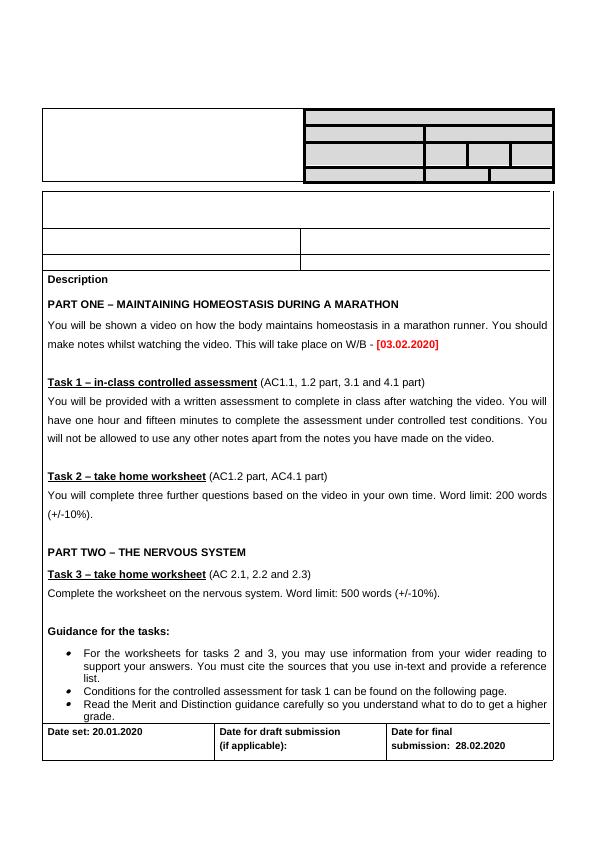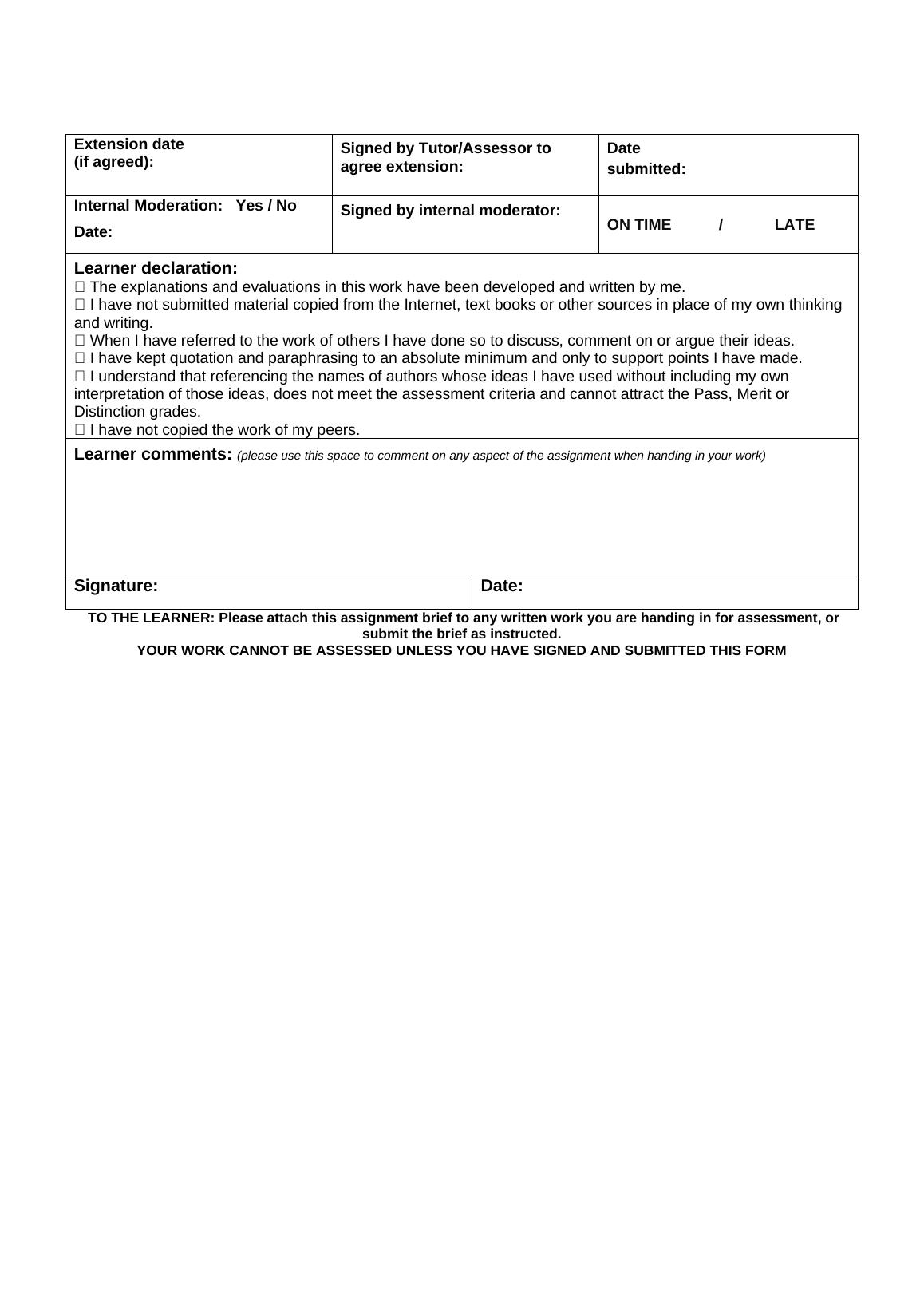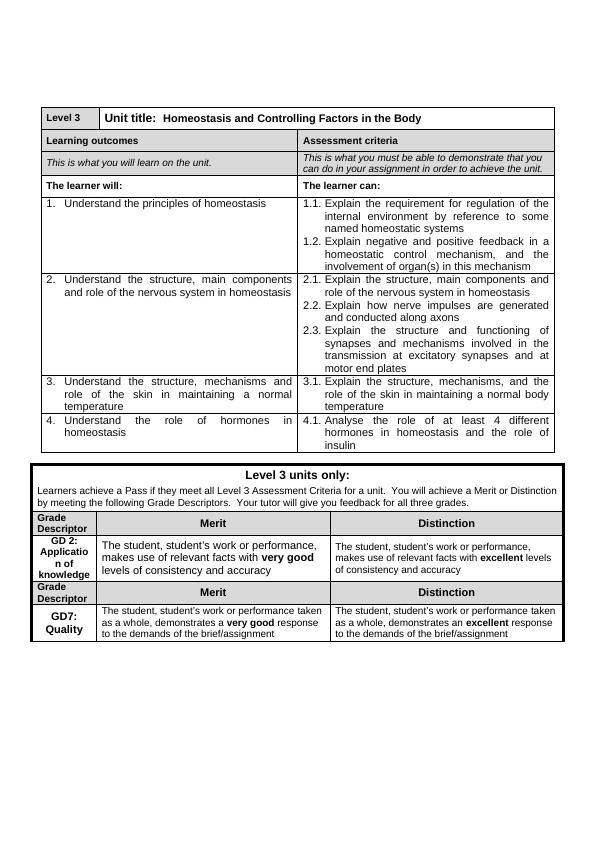Maintaining Homeostasis in a Marathon: Assessment and Worksheet
20 Pages5353 Words90 Views
Added on 2023-01-13
About This Document
This document includes information on maintaining homeostasis during a marathon, including a video, in-class assessment, and take-home worksheets on the nervous system and skin's role in maintaining body temperature.
Maintaining Homeostasis in a Marathon: Assessment and Worksheet
Added on 2023-01-13
ShareRelated Documents
“”
Description
PART ONE – MAINTAINING HOMEOSTASIS DURING A MARATHON
You will be shown a video on how the body maintains homeostasis in a marathon runner. You should
make notes whilst watching the video. This will take place on W/B - [03.02.2020]
Task 1 – in-class controlled assessment (AC1.1, 1.2 part, 3.1 and 4.1 part)
You will be provided with a written assessment to complete in class after watching the video. You will
have one hour and fifteen minutes to complete the assessment under controlled test conditions. You
will not be allowed to use any other notes apart from the notes you have made on the video.
Task 2 – take home worksheet (AC1.2 part, AC4.1 part)
You will complete three further questions based on the video in your own time. Word limit: 200 words
(+/-10%).
PART TWO – THE NERVOUS SYSTEM
Task 3 – take home worksheet (AC 2.1, 2.2 and 2.3)
Complete the worksheet on the nervous system. Word limit: 500 words (+/-10%).
Guidance for the tasks: For the worksheets for tasks 2 and 3, you may use information from your wider reading to
support your answers. You must cite the sources that you use in-text and provide a reference
list. Conditions for the controlled assessment for task 1 can be found on the following page. Read the Merit and Distinction guidance carefully so you understand what to do to get a higher
grade.
Date set: 20.01.2020 Date for draft submission
(if applicable):
Date for final
submission: 28.02.2020
Description
PART ONE – MAINTAINING HOMEOSTASIS DURING A MARATHON
You will be shown a video on how the body maintains homeostasis in a marathon runner. You should
make notes whilst watching the video. This will take place on W/B - [03.02.2020]
Task 1 – in-class controlled assessment (AC1.1, 1.2 part, 3.1 and 4.1 part)
You will be provided with a written assessment to complete in class after watching the video. You will
have one hour and fifteen minutes to complete the assessment under controlled test conditions. You
will not be allowed to use any other notes apart from the notes you have made on the video.
Task 2 – take home worksheet (AC1.2 part, AC4.1 part)
You will complete three further questions based on the video in your own time. Word limit: 200 words
(+/-10%).
PART TWO – THE NERVOUS SYSTEM
Task 3 – take home worksheet (AC 2.1, 2.2 and 2.3)
Complete the worksheet on the nervous system. Word limit: 500 words (+/-10%).
Guidance for the tasks: For the worksheets for tasks 2 and 3, you may use information from your wider reading to
support your answers. You must cite the sources that you use in-text and provide a reference
list. Conditions for the controlled assessment for task 1 can be found on the following page. Read the Merit and Distinction guidance carefully so you understand what to do to get a higher
grade.
Date set: 20.01.2020 Date for draft submission
(if applicable):
Date for final
submission: 28.02.2020

Extension date
(if agreed): Signed by Tutor/Assessor to
agree extension:
Date
submitted:
Internal Moderation: Yes / No
Date:
Signed by internal moderator: ON TIME / LATE
Learner declaration:
The explanations and evaluations in this work have been developed and written by me.
I have not submitted material copied from the Internet, text books or other sources in place of my own thinking
and writing.
When I have referred to the work of others I have done so to discuss, comment on or argue their ideas.
I have kept quotation and paraphrasing to an absolute minimum and only to support points I have made.
I understand that referencing the names of authors whose ideas I have used without including my own
interpretation of those ideas, does not meet the assessment criteria and cannot attract the Pass, Merit or
Distinction grades.
I have not copied the work of my peers.
Learner comments: (please use this space to comment on any aspect of the assignment when handing in your work)
Signature: Date:
TO THE LEARNER: Please attach this assignment brief to any written work you are handing in for assessment, or
submit the brief as instructed.
YOUR WORK CANNOT BE ASSESSED UNLESS YOU HAVE SIGNED AND SUBMITTED THIS FORM
(if agreed): Signed by Tutor/Assessor to
agree extension:
Date
submitted:
Internal Moderation: Yes / No
Date:
Signed by internal moderator: ON TIME / LATE
Learner declaration:
The explanations and evaluations in this work have been developed and written by me.
I have not submitted material copied from the Internet, text books or other sources in place of my own thinking
and writing.
When I have referred to the work of others I have done so to discuss, comment on or argue their ideas.
I have kept quotation and paraphrasing to an absolute minimum and only to support points I have made.
I understand that referencing the names of authors whose ideas I have used without including my own
interpretation of those ideas, does not meet the assessment criteria and cannot attract the Pass, Merit or
Distinction grades.
I have not copied the work of my peers.
Learner comments: (please use this space to comment on any aspect of the assignment when handing in your work)
Signature: Date:
TO THE LEARNER: Please attach this assignment brief to any written work you are handing in for assessment, or
submit the brief as instructed.
YOUR WORK CANNOT BE ASSESSED UNLESS YOU HAVE SIGNED AND SUBMITTED THIS FORM

Controlled assessment rules and procedures
Arrive for the lesson early. You will be watching the video before the assessment and if you
arrive late then you may miss vital information that you need. No one will be permitted to
enter the assessment room after the video has finished.
Mobile telephones must be switched off and placed out of reach.
You will be provided with a question and answer booklet.
You are permitted to use some pens, pencils, a ruler and a rubber. You may have a bottle of
water on your desk.
All your other personal belongings need to be left at the front of the room away from the
desks. You are not permitted to bring any notes into the assessment aside from the notes
that you make when watching the video.
Once the assessment has started you must not communicate with anyone except the
invigilator. If you need to communicate with the invigilator, you should raise your hand and
wait for her/him to come to you.
You need permission from the invigilator to leave the assessment room (e.g. to go to the
toilet). If you leave the room then you may not take the question paper, your answer booklet
or your notes with you. If you leave without permission then you will not be permitted to re-
enter the assessment.
You should not leave your desk until all your papers/scripts have been collected. You must
hand in your notes. You should not speak to your peers until you have left the assessment
room.
Any learners found to have broken the rules of assessment will have their scripts
automatically invalidated. This means that you will have to undertake a resubmission task.
Preparing for the assessment
Make sure that you have read the assessment criteria and grade guidance so that you know
what to revise and what is expected from your answers. Though some of your answers will
be based on what you have seen in the video, you should revise the general subject of
homeostasis so you are able to understand the video and provide in-depth answers.
If you normally need to be contactable by phone, ensure that those who may contact you are
aware of the times that you will be in the assessment and will not have access to your
phone.
If you require special conditions for sitting tests (e.g. extra time), inform your tutor by
22.01.2020; so that they can confirm whether you are eligible for these accommodations and
make appropriate arrangements. You should also inform your tutor if you have concerns
about watching the video (e.g. due to a sight or hearing impairment).
Arrive for the lesson early. You will be watching the video before the assessment and if you
arrive late then you may miss vital information that you need. No one will be permitted to
enter the assessment room after the video has finished.
Mobile telephones must be switched off and placed out of reach.
You will be provided with a question and answer booklet.
You are permitted to use some pens, pencils, a ruler and a rubber. You may have a bottle of
water on your desk.
All your other personal belongings need to be left at the front of the room away from the
desks. You are not permitted to bring any notes into the assessment aside from the notes
that you make when watching the video.
Once the assessment has started you must not communicate with anyone except the
invigilator. If you need to communicate with the invigilator, you should raise your hand and
wait for her/him to come to you.
You need permission from the invigilator to leave the assessment room (e.g. to go to the
toilet). If you leave the room then you may not take the question paper, your answer booklet
or your notes with you. If you leave without permission then you will not be permitted to re-
enter the assessment.
You should not leave your desk until all your papers/scripts have been collected. You must
hand in your notes. You should not speak to your peers until you have left the assessment
room.
Any learners found to have broken the rules of assessment will have their scripts
automatically invalidated. This means that you will have to undertake a resubmission task.
Preparing for the assessment
Make sure that you have read the assessment criteria and grade guidance so that you know
what to revise and what is expected from your answers. Though some of your answers will
be based on what you have seen in the video, you should revise the general subject of
homeostasis so you are able to understand the video and provide in-depth answers.
If you normally need to be contactable by phone, ensure that those who may contact you are
aware of the times that you will be in the assessment and will not have access to your
phone.
If you require special conditions for sitting tests (e.g. extra time), inform your tutor by
22.01.2020; so that they can confirm whether you are eligible for these accommodations and
make appropriate arrangements. You should also inform your tutor if you have concerns
about watching the video (e.g. due to a sight or hearing impairment).

Level 3 Unit title: Homeostasis and Controlling Factors in the Body
Learning outcomes Assessment criteria
This is what you will learn on the unit. This is what you must be able to demonstrate that you
can do in your assignment in order to achieve the unit.
The learner will: The learner can:
1. Understand the principles of homeostasis 1.1. Explain the requirement for regulation of the
internal environment by reference to some
named homeostatic systems
1.2. Explain negative and positive feedback in a
homeostatic control mechanism, and the
involvement of organ(s) in this mechanism
2. Understand the structure, main components
and role of the nervous system in homeostasis
2.1. Explain the structure, main components and
role of the nervous system in homeostasis
2.2. Explain how nerve impulses are generated
and conducted along axons
2.3. Explain the structure and functioning of
synapses and mechanisms involved in the
transmission at excitatory synapses and at
motor end plates
3. Understand the structure, mechanisms and
role of the skin in maintaining a normal
temperature
3.1. Explain the structure, mechanisms, and the
role of the skin in maintaining a normal body
temperature
4. Understand the role of hormones in
homeostasis
4.1. Analyse the role of at least 4 different
hormones in homeostasis and the role of
insulin
Level 3 units only:
Learners achieve a Pass if they meet all Level 3 Assessment Criteria for a unit. You will achieve a Merit or Distinction
by meeting the following Grade Descriptors. Your tutor will give you feedback for all three grades.
Grade
Descriptor Merit Distinction
GD 2:
Applicatio
n of
knowledge
The student, student’s work or performance,
makes use of relevant facts with very good
levels of consistency and accuracy
The student, student’s work or performance,
makes use of relevant facts with excellent levels
of consistency and accuracy
Grade
Descriptor Merit Distinction
GD7:
Quality
The student, student’s work or performance taken
as a whole, demonstrates a very good response
to the demands of the brief/assignment
The student, student’s work or performance taken
as a whole, demonstrates an excellent response
to the demands of the brief/assignment
Learning outcomes Assessment criteria
This is what you will learn on the unit. This is what you must be able to demonstrate that you
can do in your assignment in order to achieve the unit.
The learner will: The learner can:
1. Understand the principles of homeostasis 1.1. Explain the requirement for regulation of the
internal environment by reference to some
named homeostatic systems
1.2. Explain negative and positive feedback in a
homeostatic control mechanism, and the
involvement of organ(s) in this mechanism
2. Understand the structure, main components
and role of the nervous system in homeostasis
2.1. Explain the structure, main components and
role of the nervous system in homeostasis
2.2. Explain how nerve impulses are generated
and conducted along axons
2.3. Explain the structure and functioning of
synapses and mechanisms involved in the
transmission at excitatory synapses and at
motor end plates
3. Understand the structure, mechanisms and
role of the skin in maintaining a normal
temperature
3.1. Explain the structure, mechanisms, and the
role of the skin in maintaining a normal body
temperature
4. Understand the role of hormones in
homeostasis
4.1. Analyse the role of at least 4 different
hormones in homeostasis and the role of
insulin
Level 3 units only:
Learners achieve a Pass if they meet all Level 3 Assessment Criteria for a unit. You will achieve a Merit or Distinction
by meeting the following Grade Descriptors. Your tutor will give you feedback for all three grades.
Grade
Descriptor Merit Distinction
GD 2:
Applicatio
n of
knowledge
The student, student’s work or performance,
makes use of relevant facts with very good
levels of consistency and accuracy
The student, student’s work or performance,
makes use of relevant facts with excellent levels
of consistency and accuracy
Grade
Descriptor Merit Distinction
GD7:
Quality
The student, student’s work or performance taken
as a whole, demonstrates a very good response
to the demands of the brief/assignment
The student, student’s work or performance taken
as a whole, demonstrates an excellent response
to the demands of the brief/assignment

End of preview
Want to access all the pages? Upload your documents or become a member.
Related Documents
Homeostasis, Coordination & Control and the Excretory Systemlg...
|16
|4042
|725
Work and working lives in a changing business environment - Assessment ID/CIPD_7CO01_21_01lg...
|26
|8243
|405
Work and working lives in a changing business environment Assessmentlg...
|30
|9275
|282
ACMVET203A - Assist with Surgery Preparationlg...
|6
|1102
|266
BSBWHS501 Ensure a Safe Workplace Assessmentlg...
|28
|6645
|97
ACMVET201A Carry out Veterinary Nursing Reception Dutieslg...
|6
|1352
|95
